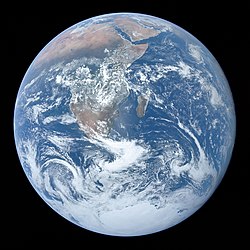
Back Ouderdom van die Aarde Afrikaans عمر كوكب الأرض Arabic Yerin yaşı Azerbaijani Узрост Зямлі Byelorussian Възраст на Земята Bulgarian পৃথিবীর বয়স Bengali/Bangla Edat de la Terra Catalan Stáří Země Czech Jordens alder Danish Ηλικία της Γης Greek

The age of Earth is estimated to be 4.54 ± 0.05 billion years (4.54 × 109 years ± 1%).[1][2][3][4] This age may represent the age of Earth's accretion, or core formation, or of the material from which Earth formed.[2] This dating is based on evidence from radiometric age-dating of meteorite[5] material and is consistent with the radiometric ages of the oldest-known terrestrial material[6] and lunar samples.[7]
Following the development of radiometric age-dating in the early 20th century, measurements of lead in uranium-rich minerals showed that some were in excess of a billion years old.[8] The oldest such minerals analyzed to date—small crystals of zircon from the Jack Hills of Western Australia—are at least 4.404 billion years old.[6][9][10] Calcium–aluminium-rich inclusions—the oldest known solid constituents within meteorites that are formed within the Solar System—are 4.567 billion years old,[11][12] giving a lower limit for the age of the Solar System.
It is hypothesised that the accretion of Earth began soon after the formation of the calcium-aluminium-rich inclusions and the meteorites. Because the time this accretion process took is not yet known, and predictions from different accretion models range from a few million up to about 100 million years, the difference between the age of Earth and of the oldest rocks is difficult to determine. It is also difficult to determine the exact age of the oldest rocks on Earth, exposed at the surface, as they are aggregates of minerals of possibly different ages.
- ^ "Age of the Earth". U.S. Geological Survey. 1997. Archived from the original on 23 December 2005. Retrieved 2006-01-10.
- ^ a b Dalrymple, G. Brent (2001). "The age of the Earth in the twentieth century: a problem (mostly) solved". Special Publications, Geological Society of London. 190 (1): 205–221. Bibcode:2001GSLSP.190..205D. doi:10.1144/GSL.SP.2001.190.01.14. S2CID 130092094.
- ^ Manhesa, Gérard; Allègre, Claude J.; Dupréa, Bernard & Hamelin, Bruno (1980). "Lead isotope study of basic-ultrabasic layered complexes: Speculations about the age of the earth and primitive mantle characteristics". Earth and Planetary Science Letters. 47 (3): 370–382. Bibcode:1980E&PSL..47..370M. doi:10.1016/0012-821X(80)90024-2.
- ^ Braterman, Paul S. (2013). "How Science Figured Out the Age of Earth". Scientific American. Archived from the original on 2016-04-12.
- ^ Hedman, Matthew (2007). "9: Meteorites and the Age of the Solar System". The Age of Everything. University of Chicago Press. pp. 142–162. ISBN 9780226322940. Archived from the original on 2018-02-14.
- ^ a b Wilde, S. A.; Valley, J. W.; Peck, W. H.; Graham C. M. (2001-01-11). "Evidence from detrital zircons for the existence of continental crust and oceans on the Earth 4.4 Gyr ago". Nature. 409 (6817): 175–178. Bibcode:2001Natur.409..175W. doi:10.1038/35051550. PMID 11196637. S2CID 4319774.
- ^ Barboni, Melanie; Boehnke, Patrick; Keller, Brenhin; Kohl, Issaku E.; Schoene, Blair; Young, Edward D.; McKeegan, Kevin D. (2017-01-06). "Early formation of the Moon 4.51 billion years ago". Science Advances. 3 (1): e1602365. Bibcode:2017SciA....3E2365B. doi:10.1126/sciadv.1602365. ISSN 2375-2548. PMC 5226643. PMID 28097222.
- ^ Boltwood, B. B. (1907). "On the ultimate disintegration products of the radio-active elements. Part II. The disintegration products of uranium". American Journal of Science. 23 (134): 77–88. doi:10.2475/ajs.s4-23.134.78. S2CID 131688682.
For the abstract, see: Chemical Abstracts Service, American Chemical Society (1907). Chemical Abstracts. New York, London: American Chemical Society. p. 817. Retrieved 2008-12-19. - ^ Valley, John W.; Peck, William H.; Kin, Elizabeth M. (1999). "Zircons Are Forever" (PDF). The Outcrop, Geology Alumni Newsletter. University of Wisconsin-Madison. pp. 34–35. Archived (PDF) from the original on 2009-02-26. Retrieved 2008-12-22.
- ^ Wyche, S.; Nelson, D. R.; Riganti, A. (2004). "4350–3130 Ma detrital zircons in the Southern Cross Granite–Greenstone Terrane, Western Australia: implications for the early evolution of the Yilgarn Craton". Australian Journal of Earth Sciences. 51 (1): 31–45. Bibcode:2004AuJES..51...31W. doi:10.1046/j.1400-0952.2003.01042.x.
- ^ Amelin, Y; Krot, An; Hutcheon, Id; Ulyanov, Aa (Sep 2002). "Lead isotopic ages of chondrules and calcium-aluminum-rich inclusions". Science. 297 (5587): 1678–83. Bibcode:2002Sci...297.1678A. doi:10.1126/science.1073950. ISSN 0036-8075. PMID 12215641. S2CID 24923770.
- ^ Baker, J.; Bizzarro, M.; Wittig, N.; Connelly, J.; et al. (2005-08-25). "Early planetesimal melting from an age of 4.5662 Gyr for differentiated meteorites". Nature. 436 (7054): 1127–1131. Bibcode:2005Natur.436.1127B. doi:10.1038/nature03882. PMID 16121173. S2CID 4304613.